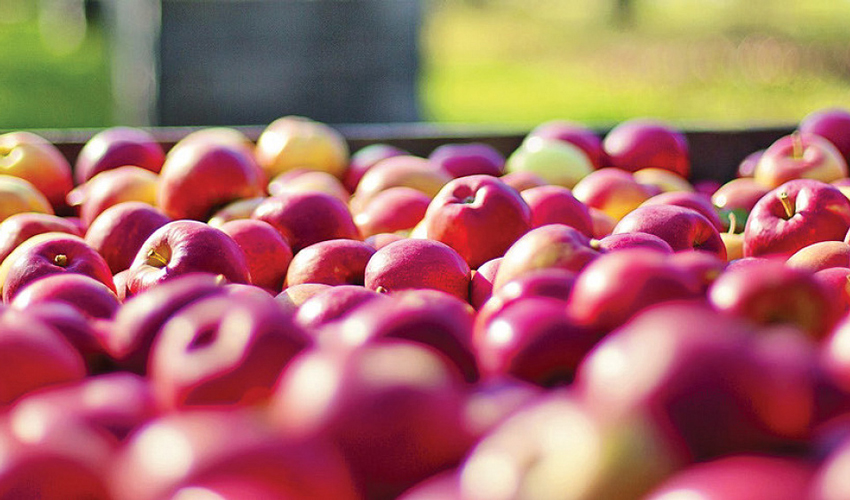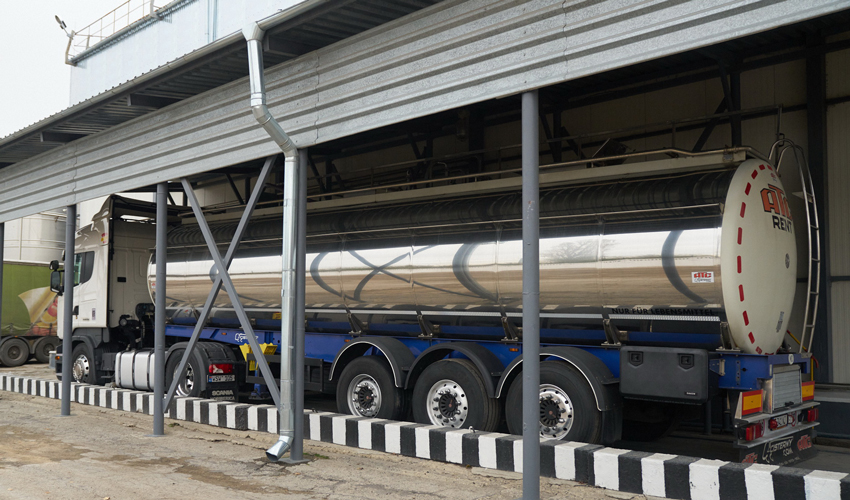
Boris Yefimov
– Autumn in Moldova is not only a carpet of yellow leaves, but also piles of apples on bare ground. And photo and video materials showing this picture in minor colors. The behind-the-scenes lists of victims and accused seem to be known: farmers in one, contractors in the other. What do you say about this situation?
– The same situation out of context can look both tragic and ordinary. Or even hopeful. An old parable comes to mind here. “If you see one person holding by the hilt a dagger that has pierced another person’s chest, don’t rush to call him a villain – perhaps he is not involved in the violence, but wants to take the dagger out and relieve the suffering.”
Apples temporarily accumulated in hoppers at the edge of the orchard for later transportation to the factory – a link in the processing cycle. It’s not the best way to harvest the crop for transportation to the processing site. But it is the fastest and cheapest way, and in certain circumstances farmers use it. This is mostly due to past or expected rains or frost. Apples are quickly picked without the use of containers, stacked along the orchard or road waiting to be loaded and shipped to factories. All these apples will be recycled with minimal waste. The video with the leitmotif – “piles of apples rotting along the roads” – is actually about everyday work, definitely not about hopelessness.
– Few grow apples specifically for the purpose of processing them into juice. In Moldova, farmers have been investing for years in modernizing horticulture and post-harvest infrastructure – refrigerators, sorting and packing lines, etc. – in order to sell more fresh apples of high quality. If a lot of apples go to processing in any given season, it means something has gone wrong for the growers. What is it?
– In the structure of this year’s harvest, the share of so-called “industrial apples” sent for processing into apple concentrate is indeed higher than in last year’s harvest. It is difficult to judge to what extent. I can only say that at the moment five Moldovan factories producing apple concentrate have processed at least 200 thousand tons of apples. The season of industrial apple processing is not over yet. It is difficult to judge how long it will last. Much will depend on weather, logistics, market conditions, prices for dessert apples sent to the so-called “fresh market” – foreign and domestic.
However, taking into account the dynamics of harvesting campaign and supplies of raw materials to the factories, there are grounds to assume that in total the enterprises of juice industry of Moldova will process about 260-280 thousand tons of apples of this year’s harvest. It can be assumed that Moldovan farmers and traders will store at least 150 thousand tons of these fruits in industrial refrigerators for sale on the “fresh market”. In total, we come out to the harvest-2025 of apples in Moldova in the range of 400-450 thousand tons. I would say closer to the upper limit of this range. For comparison, according to the National Bureau of Statistics of the Republic of Moldova, last year the apple harvest in the country amounted to 407 thousand tons. According to the Association of Fruit and Vegetable Processors Speranța Con, of this volume of production, apple concentrate factories purchased and processed about 220 thousand tons. That is, in the structure of last year’s harvest, the share of industrial apple was about 54%, in the current harvest it may be 60-70% or so.
The main reason for this situation is specific weather conditions throughout the current season: two waves of frosts in spring, drought in the second half of summer and prolonged precipitation in the first half of fall. All of this has led to a decline in apple quality. After the October rains, the apples gained a lot of moisture, and the farmers’ risks when storing them increased. Objectively speaking, most of the 2025 crop after the rains is in principle unlikely to be sold profitably on the “fresh market”. Nevertheless, there is ample evidence that even medium quality fruit, in particular the so-called “social apple” – of small caliber – is put into industrial refrigerators for storage. This is a risk, because it is not clear what the demand and prices for apples of such quality will be in winter and spring of the next year. Therefore, if a farmer decides to minimize risks now, during the harvesting campaign, we will, of course, make a step to meet and accept all the apples offered to us.

– The question is the price. The other day the local media circulated the words of one farmer who called the current purchase price of apples for processing “humiliating”. How would you comment on such a statement?
– As emotional and, partly, manipulative. Moldovan farmers remembered the purchase price for industrial apples at the end of October – beginning of November last year. At that time, for a short period of time, some farmers were offered 6 lei/kg for apples for processing. At the same time, in Poland and Ukraine, the maximum price for industrial apples did not exceed 0.25 euros/kg (5 lei/kg). However, it should be noted that at that moment the European market of industrial apple and apple concentrate was “overheated”, prices in many “apple countries” broke historical records. This was followed by a 20-30% drop in apple juice consumption everywhere in the world. Its price began to fall and approached the historical average.
Today we pay up to 2.3-2.5 lei/kg “at the factory gate”. This is a high price if we compare it with the average prices in the previous years of the quinquennium. The average purchase price of apples, not counting the price in the previous year, varied between 1.6-2.4 lei/kg in the period 2020-2023.
At the start of the new season, the price of industrial apple in Moldova reached 3.4-3.6 lei/kg. There were very cautious forecasts of apple harvest-2025 in some EU countries, important from the point of view of pricing. However, then the forecasts were adjusted upward. In particular, the estimate of apple harvest in Poland has been increased by about 25% – by 800 thousand tons, up to 4 million tons. A similar picture is observed in Ukraine, as well as, as I mentioned above, in Moldova. For this reason (the main, but not the only one) purchase prices for industrial apple in Poland have fallen to the level of 0.12-0.13 euros/kg – close, but still slightly above the statistical average. In Ukraine, the price for this raw material dropped to 6-6.5 hryvnias/kg. Moldovan apple processors had to reduce prices.
In general, it is not an exaggeration to say that the prices for industrial apple and concentrate are formed not by us, but by large global players – the USA, China, Poland. This season the world will have a fairly high apple harvest and a lot of relatively cheap apple concentrate will be produced. We will have to try hard to remain competitive.
– Usually, when the price of one or another agri-food commodity rises under the influence of some events involving those very “global players”, the world’s farming community quietly takes advantage of the situation. When the price falls, “conspiracy theories” appear. Why are the markets of industrial apple and apple concentrate so volatile?
– Two or three years ago, there were factors that gave rise to an increase in prices for apple concentrate. The first one was low apple harvests in the main “apple producing countries”, and as a consequence, the price of raw materials and processing products went up. The process was psychologically strengthened by the fact that the price of oranges and orange concentrate also went up. The second factor – the rise in the price of energy resources, for energy-intensive production of concentrate – it is a very significant increase in costs and the price of the final product. The third factor is a sharp rise in the price of sugar, the average world price has risen to a thousand dollars per ton. And expensive sugar encourages consumers to reorient from sugar-containing drinks to drinks with high fruit content.
But this year practically all basic trends, which earlier supported high prices for apple concentrate, have changed their direction – from plus to minus. The sugar price has gone down, with the EU price in particular approaching €500/t. Juice consumption has decreased, in some regions of the world very significantly – by 20-25%. Oranges and orange concentrate have fallen in price by half of the recent price. Apple concentrate production in China has recovered from the previously declared level of 300 thousand tons to the actual level of about 500 thousand tons, and possibly more. As a consequence, the price of apple concentrate “at the output” from this country recently amounted to $1700/t, now – $1300-1350/t (FOB). In the European Union apple concentrate from summer to early November lost 30-35% of the price – from 2 thousand euros to 1.3 thousand euros.
Again, there are signs that global players will make a new deal. At the moment, the US duty on apple concentrate produced in China is 54%. If the leaders of the world’s two largest economies reach a deal and the duties are reduced, it is possible that a flood of Chinese concentrate will flood into the U.S. market. This will lead to a drop in the price of juice in Europe, because European companies selling juice in the U.S. today will not be so competitive and will start dumping on the European market.
What is clear now is that our main foreign buyers of apple concentrate have already contracted the necessary volumes for the last quarter of this year and the first quarter of next year. In November, external sales (and we export more than 90% of apple concentrate produced) stopped. It looks like we will be working “on stock” until spring. Obviously, this is working in a high-risk zone. But it would be absolutely wrong to stop production and leave farmers alone with their problems. We strive to build long-term trusting relationships with partners from the agricultural sector. I repeat, we will accept all apples offered for processing, and we have no plans to reduce the purchase price.










